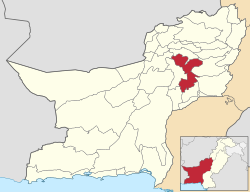Sibi (district)
| Sibi district | |
| State : |
|
| Province : | Balochistan |
| Seat : | Sibi |
| Coordinates : | 30 ° 25 ′ N , 67 ° 30 ′ E |
| Area : | 7th 796 km² |
| Residents : | 135,572 (2017) |
| Population density : | 17 inhabitants per km² |
| Time zone : | PST ( UTC + 5 ) |

|
|
The Sibi District is an administrative district in Pakistan in the Balochistan Province . The seat of the district administration is the city of Sibi .
The district has an area of 7796 km² and according to the 2017 census 135,572 inhabitants. The population density is 17 inhabitants / km².
geography
The district is located in the northeast of the Balochistan Province, which is located in the west of Pakistan. The Sibi district consists of a completely flat plain, which is located at the top and bottom of Kachhi (Bolan). The rest of the district is mountainous.
climate
The climate of the Sibi district falls into the agricultural-ecological zone I (0 to 625 meters above sea level). The climate can be divided into extremely hot summers and mild winters. The rainy season is mostly in June and July. The previous record temperature is 52.6 degrees Celsius.
Administrative division
The district is administratively divided into two tehsil :
Demographics
Between 1998 and 2017 the population grew by 1.41% annually. About 48% of the population live in urban areas and about 52% in rural areas. 71,652 men, 63,918 women and 2 transgender people live in 20,228 households, which results in a gender ratio of 105.4 men per 100 women and thus a frequent surplus of men for Pakistan. The main languages in the district are Baluch , Sindhi , Pashtun , Saraiki , Punjabi and others. The lingua franca is Urdu .
The literacy of the population over 15 years of age was 42% in 2008/09.
| year | population |
|---|---|
| 1998 | 103,746 |
| 2017 | 135,572 |
economy
Most of the workers are employed in agriculture.
Web links
Individual evidence
- ↑ a b DISTRICT WISE CENSUS RESULTS CENSUS 2017. August 29, 2017, accessed May 30, 2019 .
- ↑ Pakistani Districts wise Population Census 2017. Accessed May 30, 2019 .
- ^ District Development Profile: Ziarat. Retrieved June 28, 2019 .
